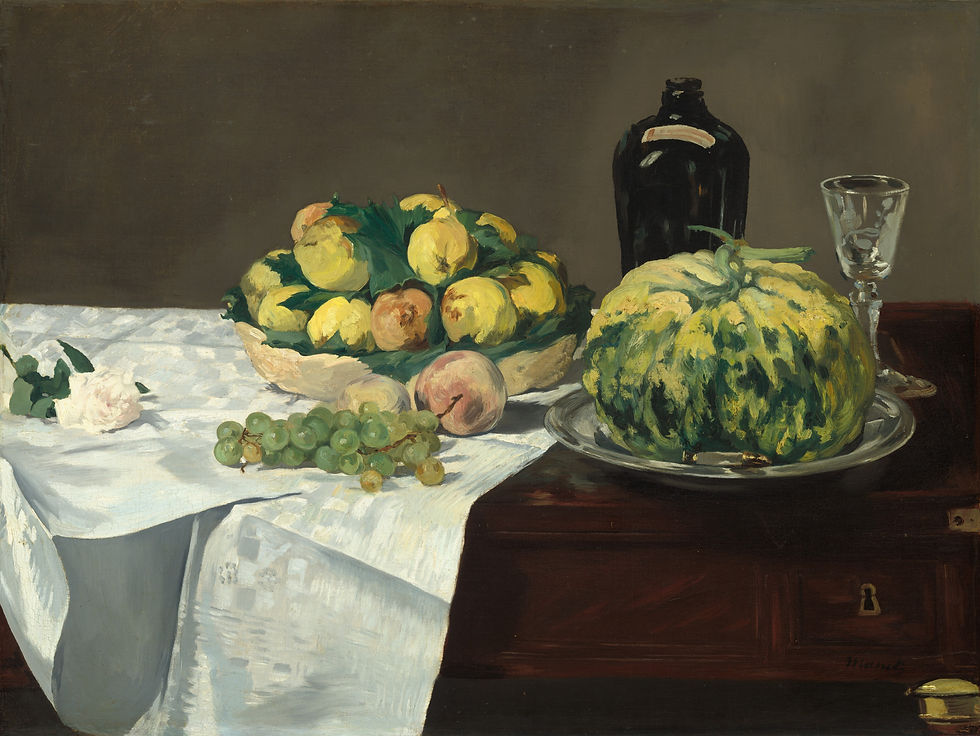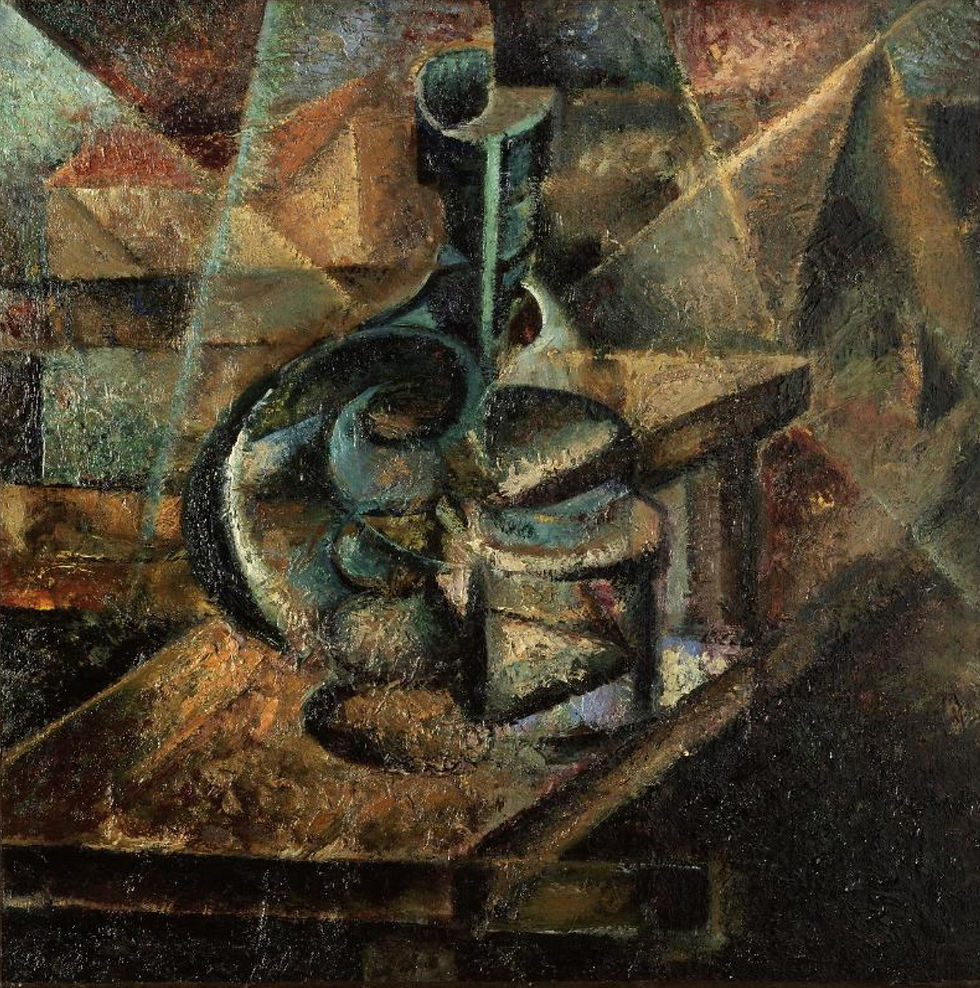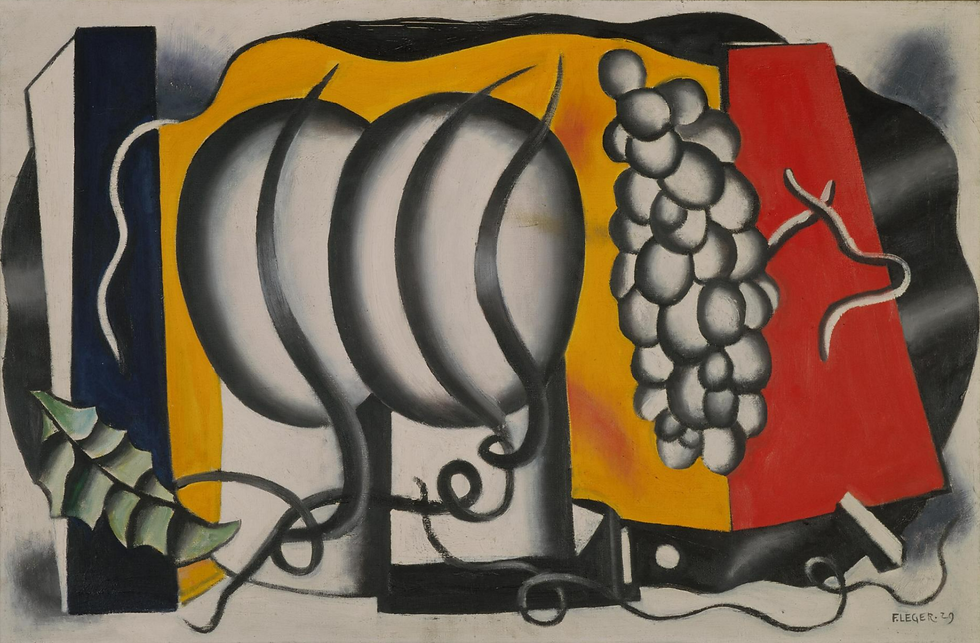From Divine to Sacred | From Drinking to Savoir-boire | From Vineyard to Port | In Still Life | In Illumination
Still Life as Document and Symbol

STILL LIFE WITH A TURKEY PIE
Pieter Claesz (ca. 1597-1661)
1627
Rijksmuseum, Amsterdam, The Netherlands
As though to prove the importance of wine and the vine in art, many artists have given these elements pride of place in still life compositions, whether symbolic or decorative. This dates back to Antiquity, as shown by the vine and grape motifs in mosaics and frescoes unearthed in the Vesuvius region of Italy. Still life began to emerge as a definable genre at the end of the sixteenth century. It would explode in popularity during the seventeenth century.
“Still life was to occupy the majority of the artistic space and the profusion of added elements adopted different aspects, evoking the opulence of well-stocked tables overflowing with food, crockery, people and animals… from a point of view which was both documentary and symbolic” (Source: Musée du Louvre).
Certain 17th-century works bear witness to contemporary dietary habits and beliefs: the lemon, ubiquitous in certain Dutch still life paintings, was believed to counteract poisons hidden in gold and silver tableware. Wine was thought to aid the digestion of melons, peaches and other fruit; while oysters were said to “awaken the appetite, the desire to eat and to share one’s bed, and [to be] as beneficial to those of a joyful character as those of more delicate disposition...” (Johan van Beverwyck, 1651). On a less prosaic level, the lemon symbolises the bitterness of existence and, when peeled, evokes the passage of time (the oysters, which can’t be conserved, convey much the same message).
17TH CENTURY

STILL LIFE WITH CHEESE Floris Claesz van Dijck , ca.1615 - Rijksmuseum, Amsterdam, The Netherlands

STILL LIFE WITH A WINE COOLER Frans Snyders, ca. 1610/20 - Fundación Banco Santander, Madrid, Spain

STILL LIFE Osias Beerl, 1617 - Palace of Versailles, France / 3

STILL LIFE WITH GRAPES, APPLES AND A JUG Georg Flegel (attrib.), 17th Cent. beginning - Private collection

STILL LIFE Clara Peeters, 1627/29 - Private collection

SERVING TABLE Juan van der Hamen, 1631 - Private collection

STILL LIFE WITH WINE GOBLET AND OYSTERS Pieter Claesz, 1639 - Museum of Fine Arts, Boston

STILL LIFE WITH LIGHTED CANDLE Pieter Claesz, 1627 - Mauritshuis, The Hague, The Netherlands

STILL LIFE WITH A ROEMER AND WATCH Willem Claesz Heda, 1629 - Mauritshuis, The Hague, The Netherlands

STILL LIFE WITH OLIVES W-C. Heda 1634 - Mus. voor Schone Kunsten, Ghent, Belgium, The Netherlands

STILL LIFE WITH OYSTERS, A SILVER TAZZA, AND GLASSWARE W-C. Heda, 1635 - Metropolitan Museum of Art, New York

STILL LIFE W-C. Heda, 1651 - Private collection

STILL LIFE WITH DRINKING-HORN Willem Kalf, 1653 - National Gallery, London

STILL LIFE WITH FRUIT, GLASSWARE, AND A WANLI BOWL Willem Kalf, 1659 - The Metropolitan Museum of Art, New York

STILL LIFE WITH A GLASS AND OYSTERS Jan Davidsz de Heem, ca. 1640 - Metropolitan Museum of Art, New York

STILL LIFE WITH GOBLET AND FRUIT Jan van de Velde, 1656 - Museum of Fine Arts (MFA), Boston, MA, United States

STILL LIFE WITH WAFER BISCUITS (LE DESSERT DE GAUFRETTES) Lubin Baugin, ca. 1631 - Musée du Louvre, Paris

STILL LIFE WITH CHESS BOARD or THE FIVE SENSES (NATURE MORTE A L’ÉCHIQUIER ou LES CINQ SENS) L. Baugin, 1630 - Mus. du Louvre, Paris
> Click on the icons for a closer look at the artworks
3. Typical of the still life in fashion in the Netherlands and the Rhineland at that time. Only the piece of pie, the knife and the strawberry placed on the table give an inkling of a sense of life.
18TH CENTURY

STILL LIFE Cristoforo Munari, 1709 - Gli Uffizi, Florence - Italy

THE DEAD WOLF (LE LOUP MORT) Jean Baptiste Oudry, 1721 - Wallace Collection, London

THE SILVER GOBLET Jean-Baptiste-Siméon Chardin, ca. 1728 - Saint Louis Art Museum, St. Louis, Missouri, United States / 3

THE SILVER GOBLET Jean-Baptiste-Siméon Chardin, ca. 1730 - Fine Arts Palace, Lille, France

SILL LIFE WITH JAR OF OLIVES (NATURE MORTE AU BOCAL D'OLIVES) Jean-Baptiste-Siméon Chardin, 1760 - Musée du Louvre, Paris

GRAPES AND POMEGRANATES (RAISINS ET GRENADES) Jean-Baptiste-Siméon Chardin, 1763 - Musée du Louvre, Paris

PEARS, WALNUTS AND GLASS OF WINE (POIRES , NOIX ET VERRE DE VIN) Jean-Baptiste-Siméon Chardin, 1768 - Musée du Louvre, Paris

STILL-LIFE Luis Meléndez, 1770 - Museo del Parado, Madrid, Spain

THE AFTERNOON MEAL (La Merienda, The Pic-nic) Luis Meléndez, ca. 1772 - The Metropolitan Museum of Art, New York
> Click on the icons for a closer look at the artworks
3. Diderot published reviews of the Salons from 1759 to 1781. He described Chardin as an illusionist who could make people believe that “a porcelain vase is made of porcelain”. He recognised “Nature herself” in Chardin’s paintings, and objects “real enough to fool one’s eyes” (Claude Frontisi, Histoire visuelle de l’art, Larousse, 2005).
19TH CENTURY

STILL LIFE WITH BOTTLE, CARAFE, BREAD, AND WINE Claude Monet, 1862/63 - National Gallery of Art, Washington

STILL LIFE WITH MELON AND PEACHES Edouard Manet, ca. 1866 - National Gallery of Art, Washington

STILL LIFE WITH APPLES AND PITCHER Camille Pissaro, 1872 - The Metropolitan Museum of Art, New York

STILL LIFE Camille Pissarro, 1867 - Museum of Art, Toledo, United States / 4

STILL LIFE WITH HAM Philippe Rousseau, 1870s - The Metropolitan Museum of Art, New York

STILL LIFE WITH OYSTERS James Ensor, 1882 - Royal Museum of Fine Arts, Antwerp, Belgium

STILL LIFE WITH BOTTLES AND EARTHENWARE Vincent Van Gogh Nov. 1884 | Apr. 1885 - Van Gogh Museum, Amsterdam, The Netherlands

THE DRESSER Paul Cézanne, 1877 - Fine Arts Museum, Budapest, Hungary

STILL LIFE WITH OINIONS Paul Cezanne, 1896/98 - Musée d'Orsay, Paris
> Click on the icons for a closer look at the artworks
4. 'Don’t bother trying to look for something new: you won’t find novelty in the subject matter, but in the way you express it', Pissaro.
20TH CENTURY, 1st HALF - MODERN ART

STILL LIFE WITH WINE BOTTLE AND GLASS Edward Hopper, 1899 - Private collection

THE BLACK BOTTLE Samuel John Peploe, ca. 1905 - National Galleries of Scotland, Edinburgh

POT, GLASS AND BOOK Pablo Picasso, 1908 - Hermitage, St Petersburg, Russia

STILL LIVE WITH GLASS, WINE BOTTLE, PACKAGE OF TOBACCO, AND NEWSPAPER Pablo Picasso, 1914 - Musée Picasso, Paris

BOTTLE AND FISHES Georges Braque, ca. 1910/12 - Tate, London / 5

STILL LIFE WITH BOTTLE Umberto Boccioni, 1912 - Pompidou Center, Paris

STILL-LIFE WITH A PIPE Chaïm Soutine, 1916 - Modern Art Museum, Troyes, France

STILL LIFE WITH THE BOTTLE OF WINE (NATURE MORTE A LA BOUTEILLE DE VIN) Kisling, 1918 - Teien Art Museum, Tokyo, Japan

STILL-LIFE WITH A PIPE Georges Braque, 1919 - Private collection

BOTTLES AND KNIVES (BOUTEILLES ET COUTEAUX) Juan Gris, 1911 - Kröller-Müller Museum, Otterlo, The Netherlands

STILL LIFE WITH NEWSPAPER Juan Gris, 1916 - The Phillips Collection

JAR AND GLASS Juan Gris, 1916 - Museo Reina Sofia, Madrid, Spain

STILL LIFE WITH THE BOTTLE OF BORDEAUX (NATURE MORTE À LA BOUTEILLE DE BORDEAUX) J. Gris, 1919 - Sammlung T. et A. Werner Coll., Berlin, Germany

BOTTLE, GLASS, AND NEWSPAPER Juan Gris, 1918 - Private collection?

BOTTLE, WINE GLASS, AND FRUIT BOWL Juan Gris, 1921 - Kunstmuseum, Basel, Switzerland

A BOTTLE AND FRUIT (UNE BOUTEILLE ET DES FRUITS) Juan Gris, 1923 - Philadelphia Museum of Art, PA, United States

KNIFE AND FRUIT IN FRONT OF THE WINDOW Diego Rivera, 1917 - Museo Dolores Olmedo, Mexico, Mexixo

STILL LIFE WITH FRUIT BASKET Braque, 1925 - Private collection

KNIFE AND FRUIT IN FRONT OF THE WINDOW Diego Rivera, 1917 - Museo Dolores Olmedo, Mexico, Mexixo

STILL LIFE WITH GLASS OF RED WINE (NATURE MORTE AU VERRE DE VIN ROUGE) Amédée Ozenfant, 1921 - Kunstmuseum, Basel, Suisse

STILL LIFE WITH EGG (NATURE MORTE A L'ŒUF) Le Corbusier, 1919 - Le Corbusier Fundation, Paris

STILL LIFE Le Corbusier, 1920 - MoMA, New York

THE BOTTLE OF ORANGE WINE (LA BOUTEILLE DE VIN ORANGE) Le Corbusier, 1922 - Le Corbusier Fundation, Paris

STILL LIFE Salvador Dali, 1923 - Reina Sofia Museum, Madrid

THE BOTTLE OF WINE Joan Miró, 1924 - The Fundació Joan Miró, Barcelona, Spain

STILL LIFE Fernand Léger, 1924 - Private collection

COMPOSITION Fernand Léger, 1929 - Pompidou Centre, Paris

THE BOTTLE OF WINE Pablo Picasso, 1926 - Beyeler Fundation, Riehen, Basel-Stadt, Switzerland

STILL LIFE WITH GLASS OF WINE (NATURE MORTE AU VERRE DE VIN) Emile Othon Friesz, 1929 - Pompidou Centre, Paris

INN COUNTER Erich Wegner, 1927 - Von der Heydt Museum, Wuppertal, Germany

STILL LIFE WITH A FIGURE Balthus, 1940 - Tate, London

STILL LIFE WITH BOTTLE OF RED WINE (NATURE MORTE A LA BOUTEILLE DE VIN ROUGE) Pierre Bonnard, 1942 - Private collection

STILL LIFE Georgio Morandi, 1951 -Morandi Museum, Bologna, Italy
> Découvrez les oeuvres dans leur entier en cliquant sur les vignettes
In the 19th c., still life paintings were considered essentially documentary. In the 20th c. , artworks of this type – whether futurist, cubist, surrealist or hyper-realist – were seen more an extension of the artist’s personality, an expression of style and individual talent.
5. A traditional domestic subject matter again, with a bottle and fishes on a plate, laid on a table with a drawer: ordinary objects, but fragmented to form a grid-like structure.
20TH CENTURY, 2nd HALF - CONTEMPORARY ART

STILL LIFE WITH THW BOTTLES Bernard Buffet, 1949 - Private collection

STILL LIFE Nicolas de Staël, 1955 - Private collection

STILL LIFE WITH GLASS Nicolas de Staël, 1954 - Private collection

BOTTLES Nicolas de Staël, 1952 - Private collection

RED BOTTLES Nicolas de Staël, 1955 - Private collection

THREE BOTTLES Fernand Léger, 1954 - Tate Moder, London

STILL LIFE - FAST MOVING Salvador Dali, 1956 - The Fundació Gala-Salvador Dalí, Figueres, Girona, Spain

BREAD AND WINE (PAIN ET VIN) Claude Yvel, 1964

STILL LIFE WITH PALETTE Roy Lichtenstein, 1972 - Private collection

'THEY LOOK LIKE TWO BOTTLES' (comment by the artist) Paul Fréour, 1973 - Private collection

GLASS OF WINE (COPA) Tàpies, 1997 - Vivanco, Briones, La Rioja, Spain

STILL LIFE Georg Baselitz, 1976/77 - MoMA, New York

BOTTLE WITH APPLE Gerhard Richter, 1988 - Private collection

STILL-LIFE WITH BREAD AND WINE David Ligare, 2007 - Private collection

TABLE Isabel Baquedano - Fine Arts Museum, Bilbao, Spain / 15
> Click on the icons to explore the artworks in depth
15. Isabel Baquedano nous indique qu'une table peut être "mise" sans bouteille de vin !
IMAGINATION MEETS REALITY

THE PORTRAIT
René Magritte, 1935
Museum of Modern Art, New York City
“… Visitors say the usual snide nonsense: ‘it’s less profound than usual!’, ‘it’s the Belgian spirit!’ ...” This was how René Magritte described to a colleague the public reaction to his latest works. As in The Magician, the surrealist Magritte transforms a familiar, banal scene into a strange and intriguing painting. He “shows us how [as in all his works] painting can stand between visible reality and imaginary depiction.” (Source: Magritte, Marcel Paquet, Taschen, Cologne). Like any painter, he has the magic ability to copy reality while permitting himself to betray it. There are elements in Magritte which, when placed in opposition, awaken the spirit and allow questions to be asked.
Here the artist juxtaposes the slice of ham on the plate and the eye in the middle of it, gazing out at us: is it defiant, or inviting the viewer to take a seat at the table? Thus does mystery enter the humdrum. The work’s title adds to the confusion. The eye undermines the still life, evoking a portrait: of the pig, perhaps, or maybe of a guest ready to join the scene. The result is direct, disconcerting and troubling. It pushes us beyond the visible, towards “that which is hidden by that which we see.” Magritte goes beyond appearances and lends an element of mystery to the real world: “I ensure that, as far as possible, I only work on paintings which create mystery with the precision and enchantment necessary to the life of ideas.”
THE VIRTUAL WINE MUSEUM'S PAINTING COLLECTIONS






